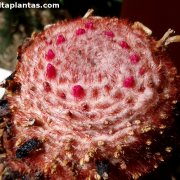Care of the cactus Melocactus deinacanthus or Turk's cap cactus |
|
The genus Melocactus, family Cactaceae, comprises 40 species of cacti native to Mexico, Cuba, Central and South America. Some species are: Melocactus deinacanthus, Melocactus curvispinus, Melocactus conoideus, Melocactus bahiensis, Melocactus azureus, Melocactus oreas, Melocactus intortus, Melocactus intortus, Melocactus schatzlii, Melocactus peruvianus, Melocactus ernestii, Melocactus matanzanus. Common names: Turk's cap cactus, Wonderfully Bristled Turk's-Cap Cactus. Scientific synonyms: Melocactus ernestii. This species is native to Brazil. They are cacti with a light green color, slow growth and a cylindrical body that reach 30 cm (11.8") in height. They have 10-12 sharp ribs, 3-5 radial spines, and 4 central spines. The great cephalia (up to 20 cm/7.87" tall) have reddish hairs and abundant white wool. The flowers are purple and the fruits are white. Turk's cap cactus is used in pots for patios, balconies and terraces, as indoor or greenhouse plants. In subtropical climates it's used in rockery. Melocactus deinacanthus needs direct sun exposure and high temperatures. It does not resist temperatures below 12 ºC (53.6 ºF). The soil can be a mixture of 75% leaf mulch or heather soil and 25% coarse siliceous sand. Transplant as little as possible because the roots are delicate. Wonderfully Bristled Turk's-Cap Cactus is a plant resistant to drought; water waiting until the substrate has dried well. From late autumn to early spring there is no need to water. Melocactus deinacanthus does not need pruning or fertilizers. The biggest enemy of Turk's cap cactus is excess humidity. Melocactus ernestii propagates from seeds sown in spring but it's a slow process. |
Images of the cactus Melocactus deinacanthus or Turk's cap cactus |
Find plants
Melocactus deinacanthus or Turk's cap cactus | Care and Growing
© 2026 FavThemes

